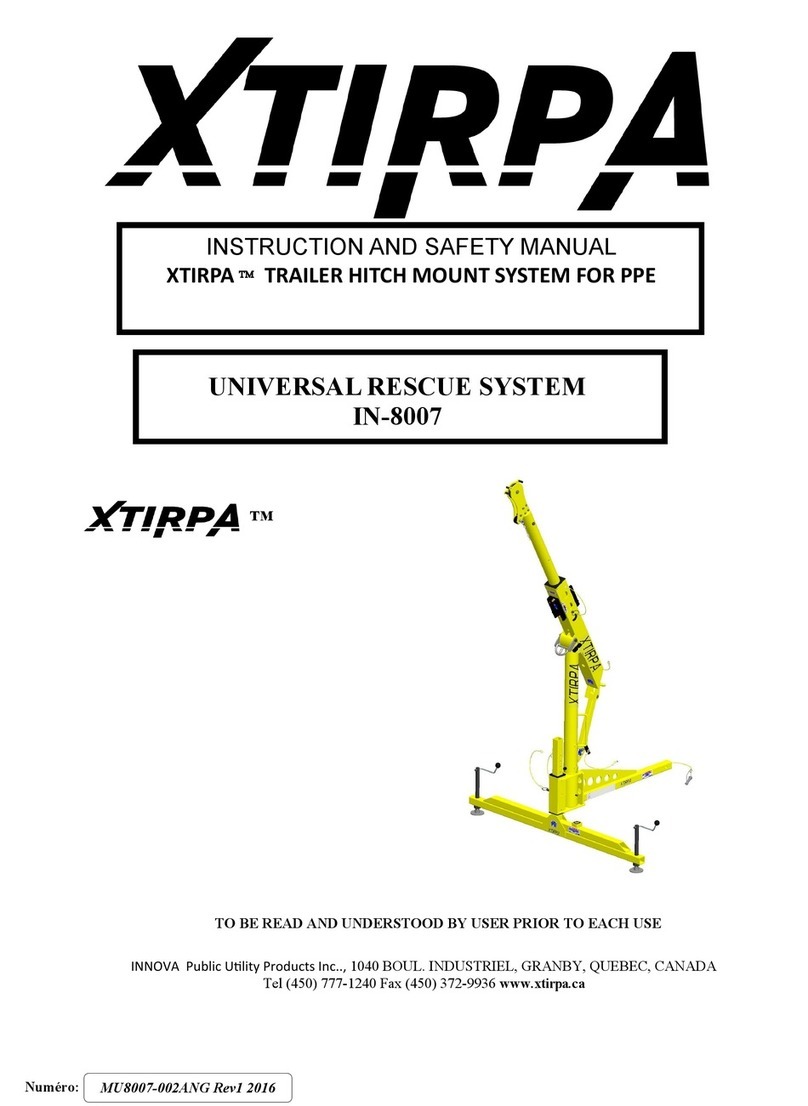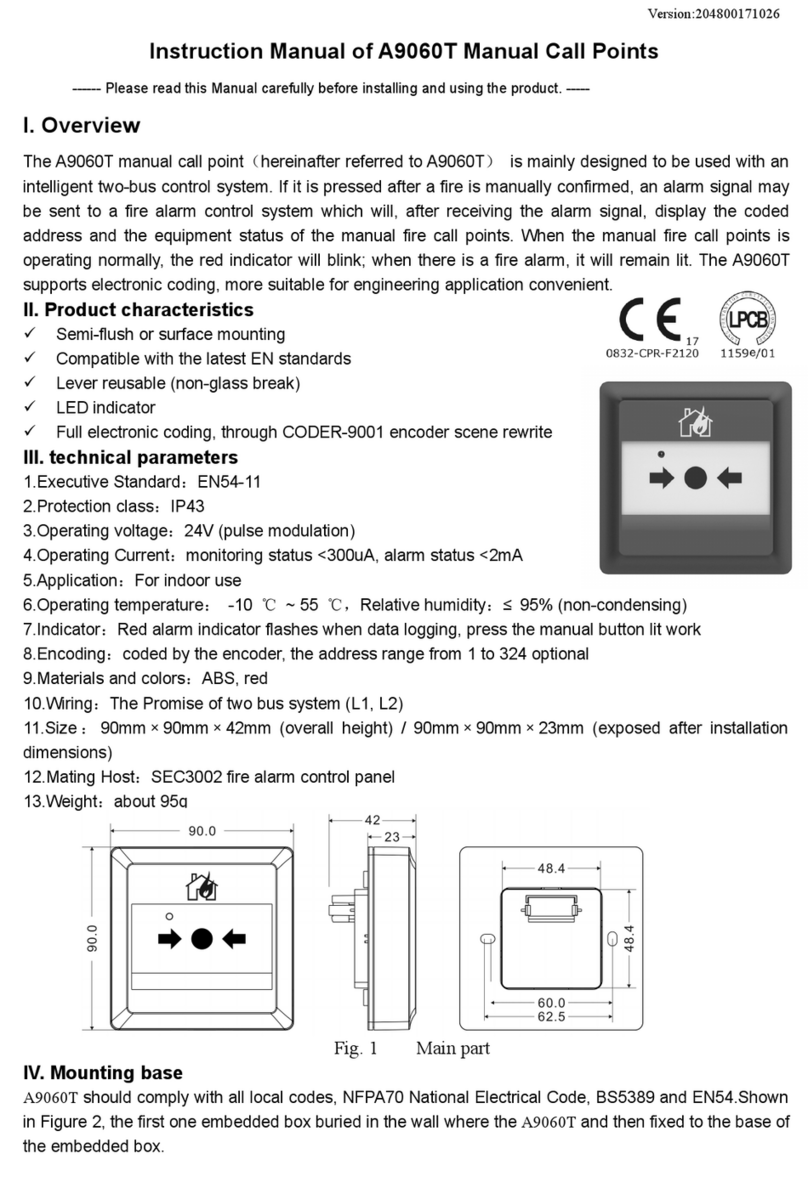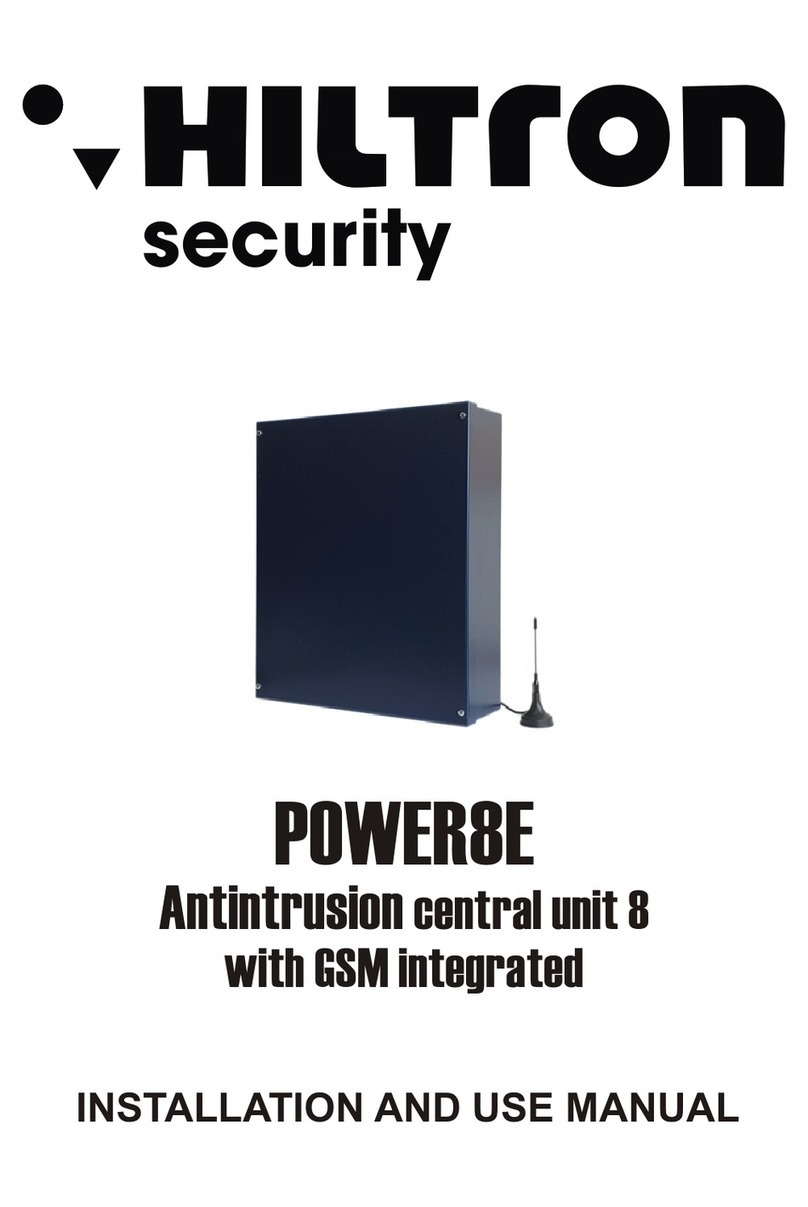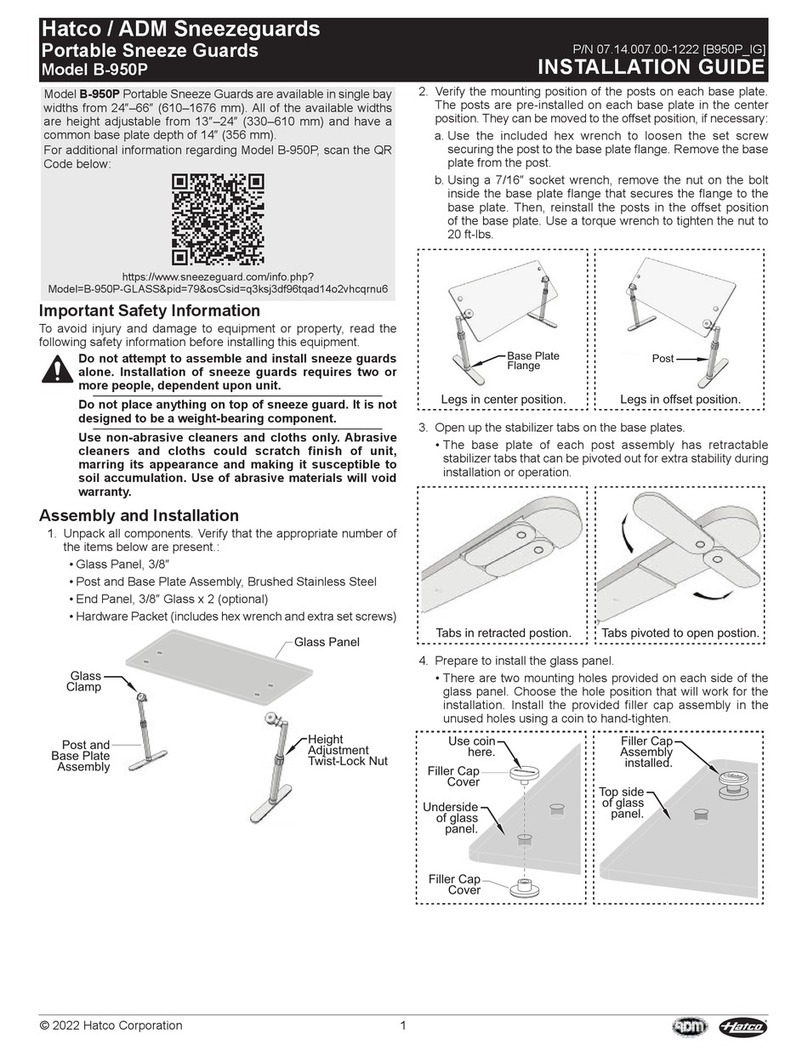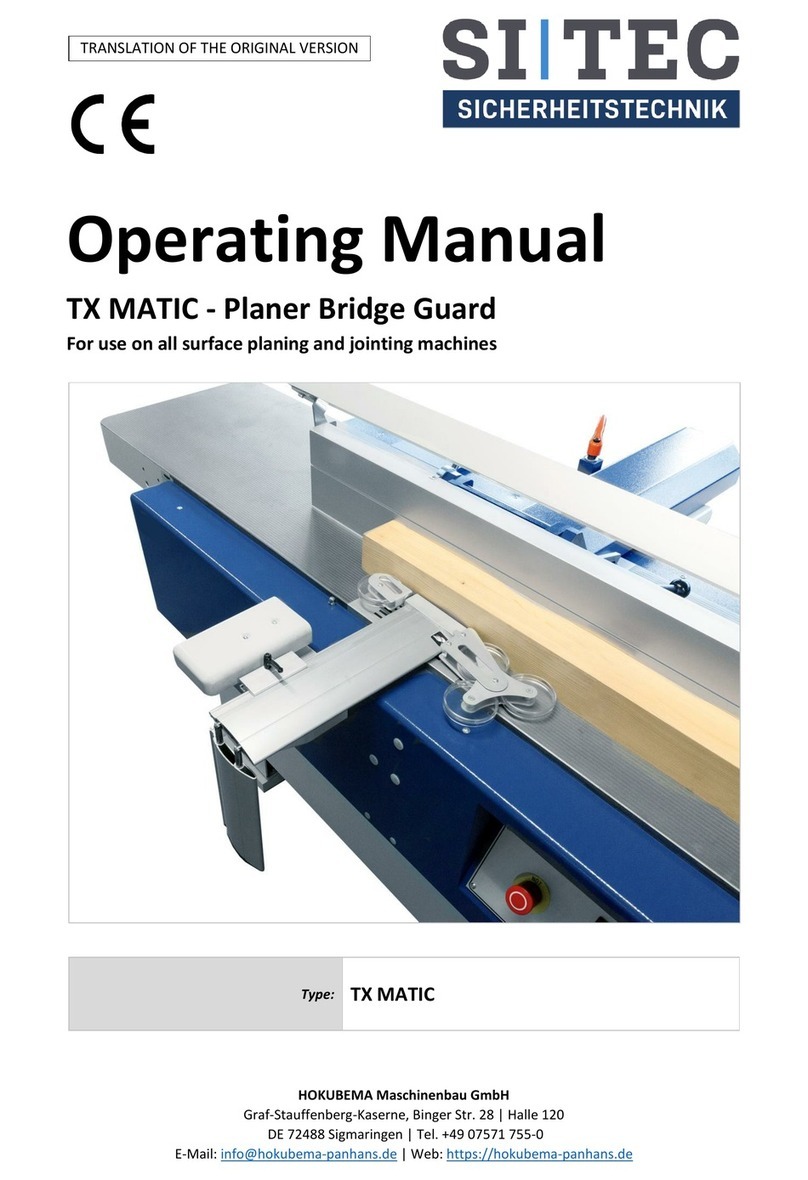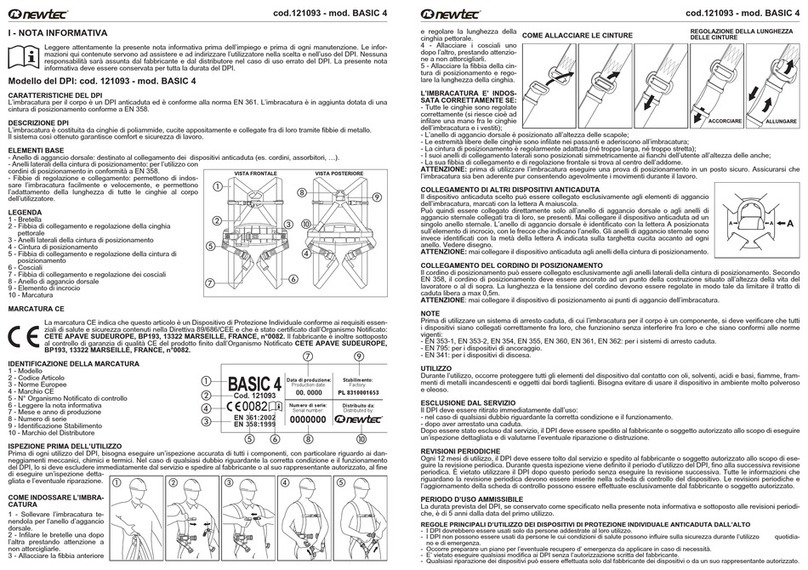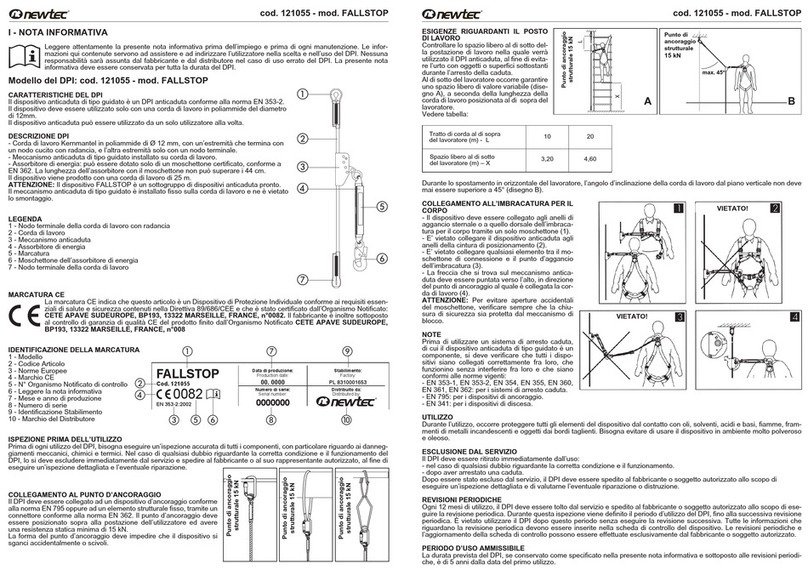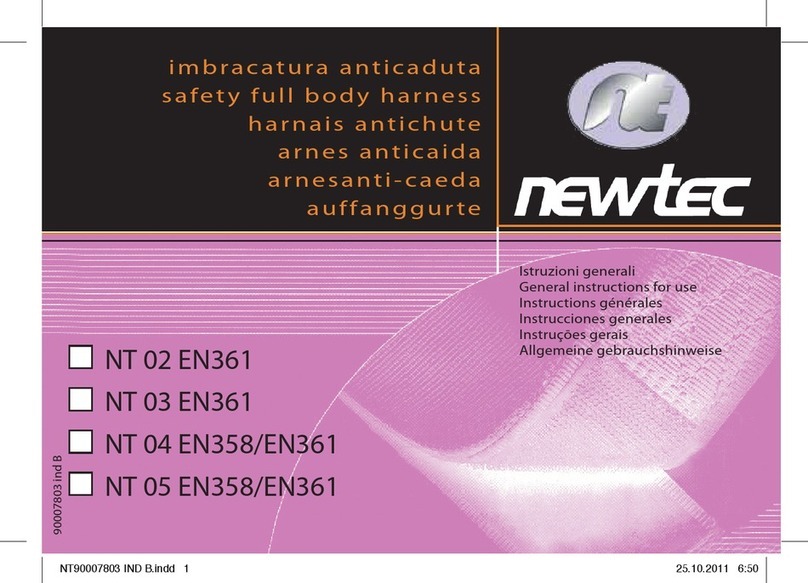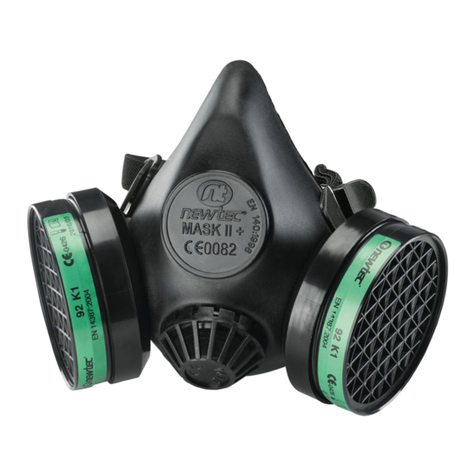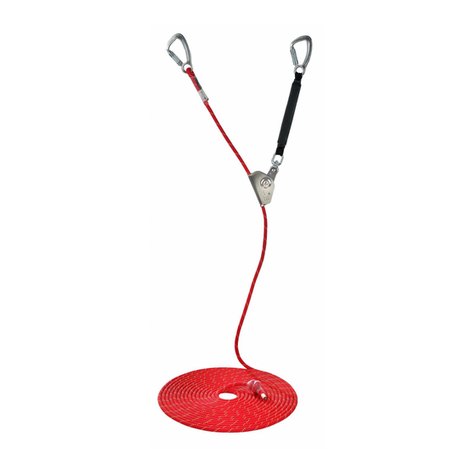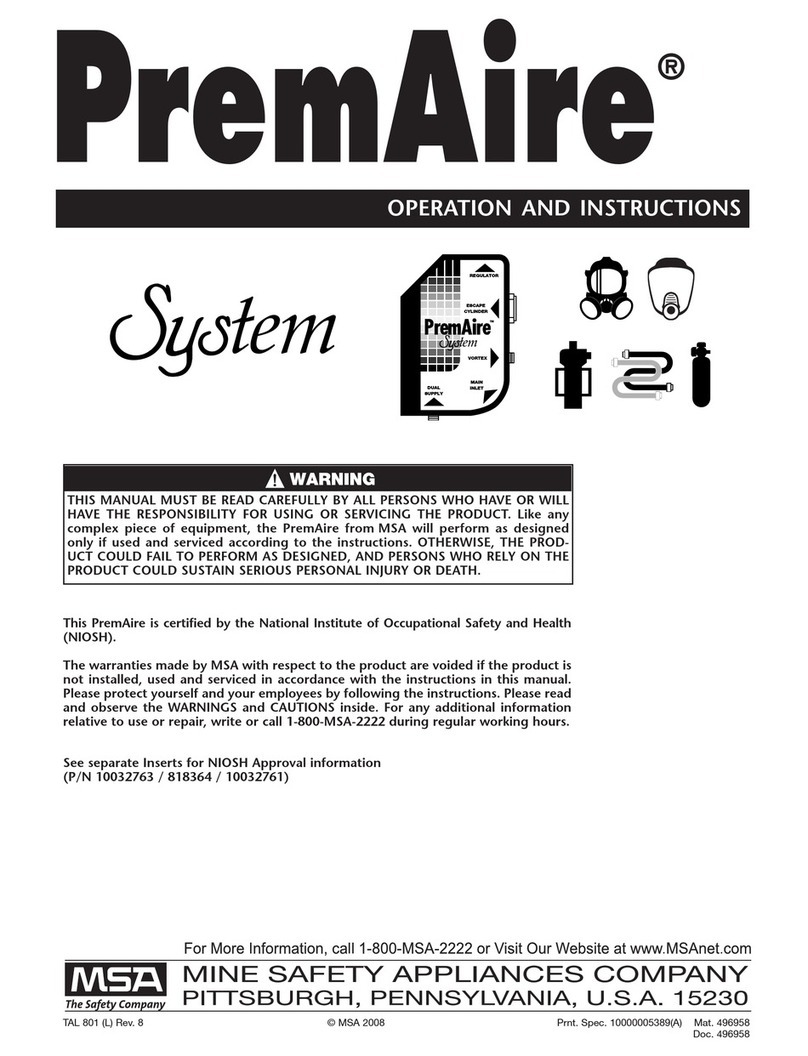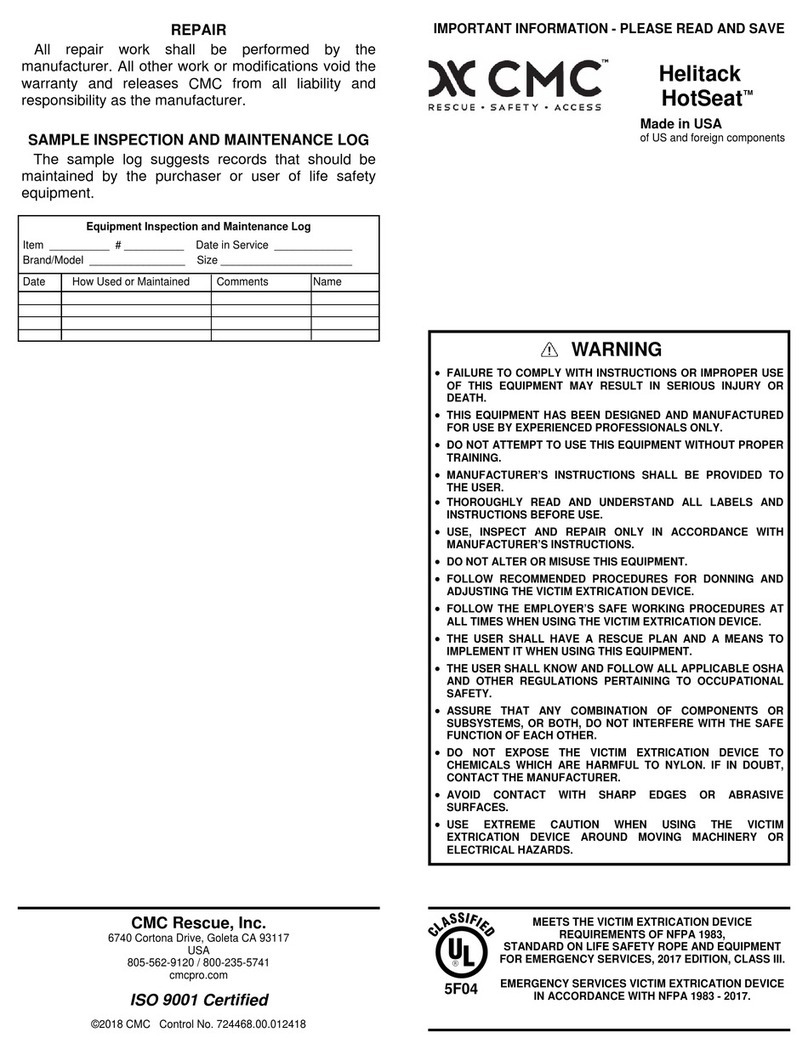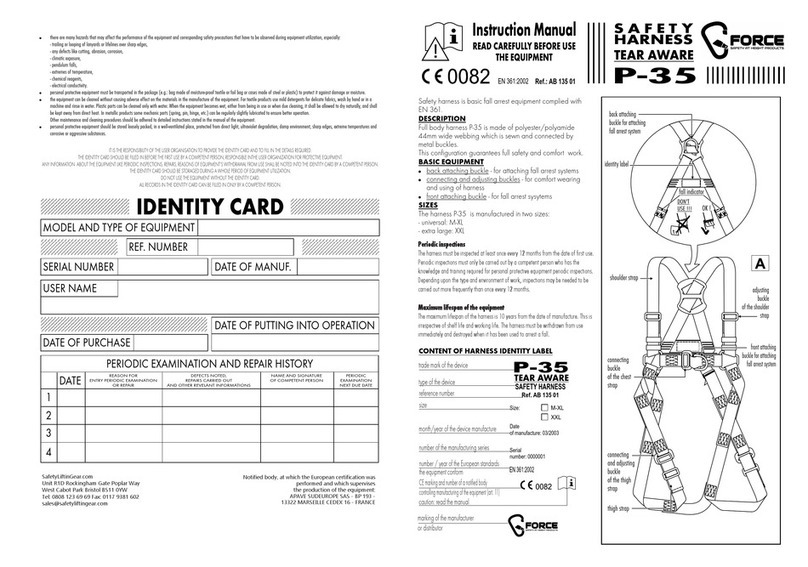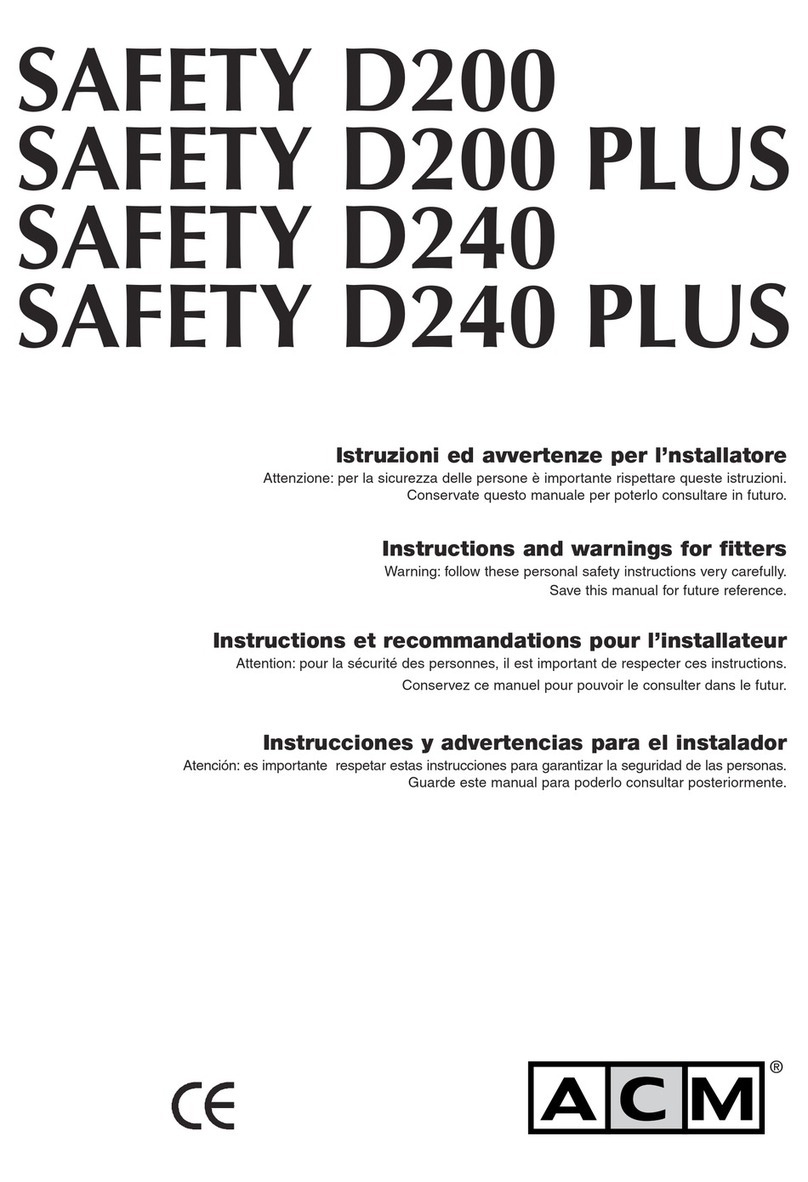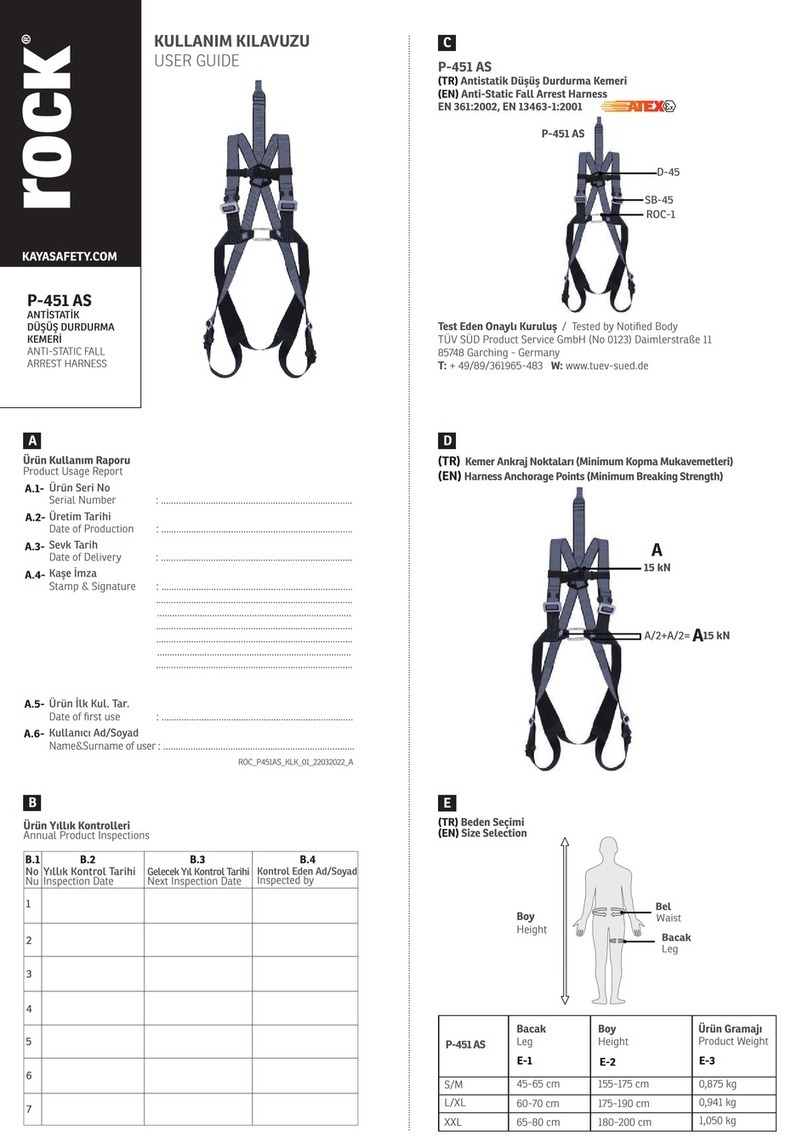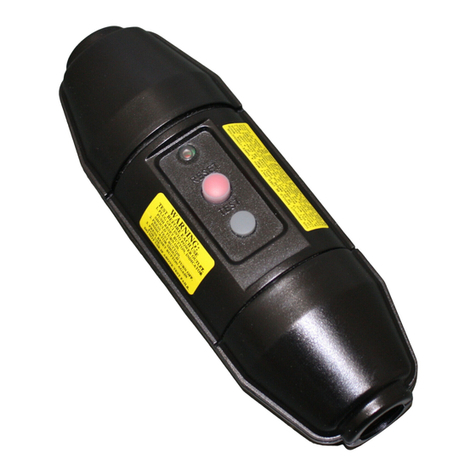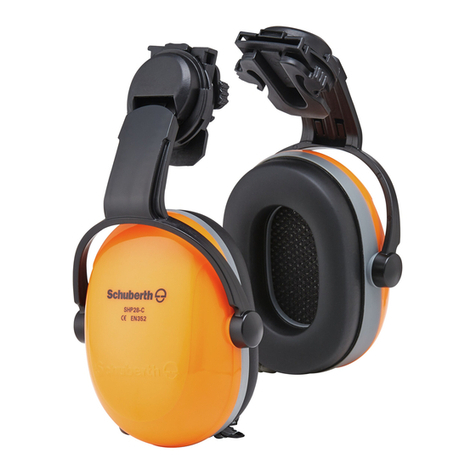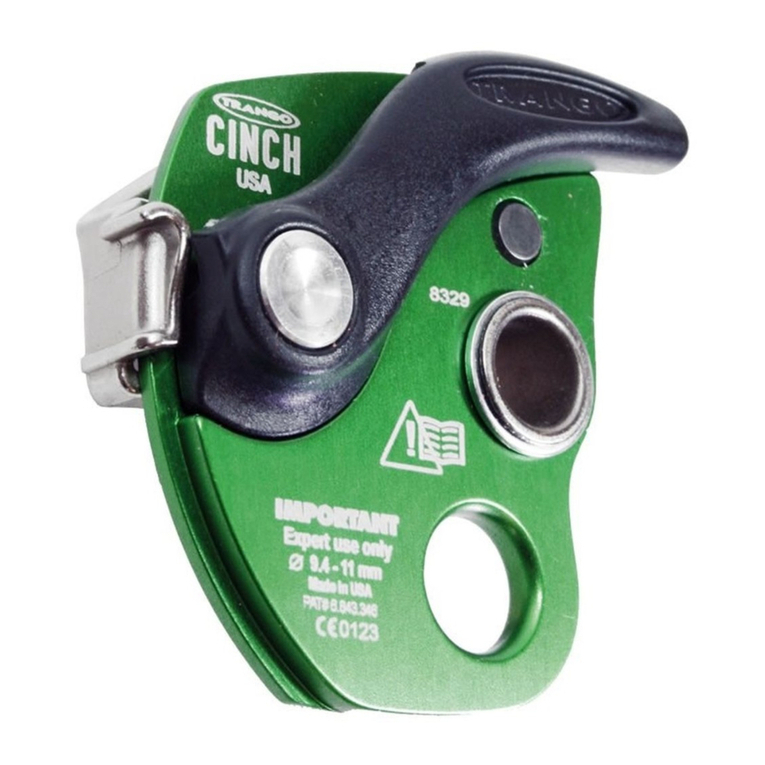
WICHTIGER HINWEIS!
Der Haltegurt mit dem Sicherungs-
seil ist keine Absturzsicherung! Bei
Arbeiten in der Höhe muss der Arbei-
ter zusätzlich zum Haltegurt auch ei-
nen Körpergurt tragen und durch ein
Auffangsystem abgesichert werden.
Der Haltegurt darf keinesfalls als
Körpergurt benutzt werden. Der Kör-
pergurt gemäß EN 361 ist die einzi-
ge zugelassene Haltevorrichtung für
den Körper in einem Auffangsystem.
VERBINDUNG DES HALTESEILS
Das Halteseil darf ausschließlich mit den Seitenösen des Haltegurtes verbunden werden. Gemäß EN 353 muss das Halteseil
an einer Stelle der Struktur befestigt werden, die sich in Taillenhöhe des Benutzers oder darüber befindet. Länge und Span-
nung des Seils müssen so eingestellt sein, dass die Strecke im freien Fall max. 0,5 m beträgt.
GEBRAUCH
Während der Verwendung sollte vermieden werden, dass die Elemente der Vorrichtung mit Öl, Lösungsmitteln, Säuren und
Laugen, Flammen, glühenden Metallteilen und scharfkantigen Gegenständen in Berührung kommen. Die Vorrichtung sollte
nicht in sehr staubigen oder ölreichen Umgebungen benutzt werden.
AUSSCHLUSS VON DER VERWENDUNG
Die PSA muss unverzüglich von der Verwendung ausgeschlossen werden, wenn irgendwelche Zweifel in Bezug auf ihren ein-
wandfreien Zustand und Funktion auftreten. Anschließend muss sie dem Hersteller oder einer befugten Person zwecks einer
gründlichen Untersuchung und evtl. Instandsetzung bzw. Entsorgung zugeschickt werden. Hat sie hingegen einen Absturz
gestoppt, muss sie unverzüglich vernichtet werden.
REGELMÄSSIGE ÜBERHOLUNGEN
Nach einer Verwendungszeit von 12 Monaten muss die PSA eingezogen und dem Hersteller oder einer befugten Person
zugeschickt werden, um eine Überholung durchzuführen. Bei dieser Überprüfung wird die Verwendungszeit der PSA bis zur
nächsten regelmäßigen Überholung festgelegt. Die PSA darf keinesfalls nach Ablauf dieses Zeitraums benutzt werden, ohne
dass sie überholt wurde. Alle Informationen in Bezug auf die regelmäßige Überholung müssen im Prüfblatt der Vorrichtung
eingetragen werden. Die regelmäßigen Überholungen und die Aktualisierung des Prüfblatts dürfen ausschließlich vom Her-
steller oder der befugten Person durchgeführt werden.
ZULÄSSIGE VERWENDUNGSZEIT
Wird die PSA entsprechend den in diesem Informationsblatt enthaltenen Anweisungen aufbewahrt und regelmäßigen Überho-
lungen unterzogen, sollte ihre Lebensdauer 5 Jahre ab dem Zeitpunkt der ersten Verwendung betragen.
GRUNDREGELN FÜR DIE VERWENDUNG VON PERSÖNLICHEN SCHUTZAUSRÜSTUNGEN GEGEN ABSTURZ AUS
DER HÖHE
- Die PSA sollten nur von Personen benutzt werden, die mit ihrer Anwendung vertraut sind.
- Die PSA dürfen keinesfalls von Personen benutzt werden, deren Gesundheitszustand während der täglichen Verwendung
und in Notsituationen die Sicherheit beeinträchtigen könnte.
- Für einen evtl. eintretenden Notfall sollte ein Rettungsplan bereit gestellt werden.
- Jegliche Änderung der PSA ohne die schriftliche Genehmigung des Herstellers ist untersagt.
- Nur der Hersteller oder ein von ihm zugelassener Vertreter sind dazu befugt, Reparaturen an den Vorrichtungen auszuführen.
- Die PSA dürfen keinesfalls auf eine andere als die vorgesehene Weise verwendet werden.
- Die PSA sind individuelle Vorrichtungen und dürfen daher nur von einer Person verwendet werden.
- Vergewissern Sie sich vor der Verwendung, dass alle Elemente richtig miteinander verbunden sind.
- Überprüfen Sie regelmäßig alle Verbindungen und die Einstellung aller Elemente, um ein unbeabsichtigtes Lockern bzw.
Ablösen zu vermeiden.
- Keinesfalls dürfen PSA zusammen verwendet werden, wenn ein Element der einen Vorrichtung ein Element der anderen
beeinträchtigt.
- Führen Sie vor jeder Verwendung der PSA eine sorgfältige Sichtkontrolle ihres Zustands und ihrer Funktionsfähigkeit durch.
- Achten Sie bei dieser Kontrolle insbesondere auf Beschädigungen, überhöhten Verschleiß, Rosterscheinungen, Abrieb,
Schnitte oder Funktionsstörungen. Achten Sie besonders auf die folgenden Elemente:
in Körpergurt und Haltegurt: Schnallen, Einstellelemente, Verbindungspunkte, Riemen, Schlaufen, Nähte;
bei den Falldämpfern: Verbindungsknoten, Band/Riemen, Nähte, Verbindungselemente;
bei den Sicherungsseilen: Seil, Knoten, Kauschen, Verbindungselemente, Einstellelemente, Verflechtungen;
bei den Stahlseilen von Seilsicherungssystemen: Stahlseil, Endstücke, Klemmen, Knoten, Kauschen, Verbindungselemente, Einstellelemente;
bei den Auffanggeräten mit Aufroller: Seil/Band, die einwandfreie Funktion des Aufrollers und der Sperrvorrichtung, das
Gehäuse, Falldämpfer, Verbindungselemente;
bei den Auffanggeräten mit Führung: Gerätekörper, das einwandfreie Gleiten des Seils in der Führung, die einwandfreie
Funktion der Sperrvorrichtung, Niete, Schrauben, Verbindungselemente, Falldämpfer;
bei den Verbindungselementen: Tragkörper, Vernietung, Öffnung, die einwandfreie Funktion der Sperrvorrichtung.
- Wird die Vorrichtung außerhalb ihres Herkunftslandes verkauft, muss der Hersteller die entsprechenden Anweisungen über
ihren Gebrauch und Aufbewahrung sowie die Informationen über die regelmäßigen Überholungen und Reparaturen in der
Sprache des zukünftigen Benutzerlandes mitliefern.
- Der mit der Richtlinie EN 361 konforme Körpergurt ist die einzige zulässige Vorrichtung, um den Körper zwischen den PSA
gegen Absturz zu halten.
D - INFORMATIONSBLATT
Dieses Informationsblatt vor dem Gebrauch und vor jeder Wartung aufmerksam lesen. Die in diesem Informa-
tionsblatt enthaltenen Informationen sollen dem Anwender bei der Wahl und dem Gebrauch der persönlichen
Schutzausrüstungen helfen. Der Hersteller und der Vertragshändler haften nicht bei einem falschen Gebrauch
der persönlichen Schutzausrüstungen. Dieses Informationsblatt muss über die gesamte Lebensdauer der persön-
lichen Schutzausrüstung aufbewahrt werden.
Modell der PSA: cod. 121090 - mod. BASIC 1
MERKMALE DER PSA
Der Haltegurt ist eine PSA zur Positionssicherung und zur Verhinderung von Abstürzen; sie entspricht der Richtlinie EN 358.
BESCHREIBUNG DER PSA
Der Sitzgurt besteht aus einem genähten und mit einer Metallschnalle verbundenen Polyamidband.
Der Sitzgurt ist mit einem Polster aus Spezialschaum ausgestattet.
DIE GRUNDELEMENTE
- Seitenösen: zur Verbindung an eine Haltevorrichtung.
- Polster
- Einstell-und Verbindungsschnalle: ermöglicht ein schnelles und einfaches Anlegen des Gurtes und das Anpassen der Band-
länge an den Körper des Benutzers.
ERLÄUTERUNGEN
1- Verbindungs- und Einstellschnalle
2 - Seitenösen
3 - Polster
4 - Markierung
CE-KENNZEICHNUNG
Die CE-Kennzeichnung weist darauf hin, dass dies Artikel zu den persönlichen Schutzausrüstungen zähle und
den wesentlichen Gesundheits- und Sicherheitsvorschriften der Richtlinie 89/686/ECE entspricht und dass es von
dem folgenden Institut bescheinigt wurde: CETE APAVE SUDEUROPE, BP193, 13322 MARSEILLE, FRANCE,
n°0082. Der Hersteller wird ferner der CE-Qualitätsgewährleistungskontrolle des Endprodukts durch folgendes
Institut unterzogen CETE APAVE SUDEUROPE, BP193, 13322 MARSEILLE, FRANCE, n°0082.
DIE MARKIERUNG
1 - Modell
2 - Artikel-Code
3 - Europäische Richtlinien
4 - CE-Markierung
5 - Kenn-Nr. der eingetragenen Kontrollstelle
6 - Hinweise beachten
7 - Herstellungsjahr und -monat
8 - Seriennummer
9 - Werksnummer
10 - Marke des Großhändlers
KONTROLLEN VOR DER BENUTZUNG
Vor der Verwendung einer PSA müssen alle Elemente sorgfältig untersucht werden; achten Sie insbesondere auf mecha-
nische, chemische und thermische Beschädigungen. Treten irgendwelche Zweifel in Bezug auf den einwandfreien Zustand
bzw. Funktion der PSA auf, darf sie keinesfalls benutzt, sondern muss dem Hersteller oder seinem Vertreter zwecks einer
genaueren Überprüfung und evtl. Reparatur zuge-
schickt werden.
DER GURT IST RICHTIG ANGELEGT, WENN:
- Der Gurt richtig angepasst ist (nicht zu weit und
nicht zu eng);
- Die Seitenösen symmetrisch und in Hüfthöhe an
den Seiten des Benutzers liegen;
- Die Verbindungs- und Einstellschnalle sich in der
Mitte des Unterleibs befindet;
- Die freien Bandenden in die Schlaufen eingeführt
sind.
p
A
cod. 121090 - mod. BASIC 1 cod. 121090 - mod. BASIC 1
BASIC 1
Cod. 121090
EN 358:1999
0082
PL 8310001653
00. 0000
0000000
Data di produzione:
Production date:
Numero di serie:
Serial number:
Stabilimento:
Factory:
Distribuito da:
Distributed by:
a
b
d
c
e
g
f h
i
j
DAS ANLEGEN DES HALTEGURTS
DAS SCHLIESSEN DER GURTE EINSTELLEN DER GURTLÄNGE
VERKÜRZEN VERLÄNGERN
d
c
a
b
VORDERANSICHT RÜCKANSICHT
